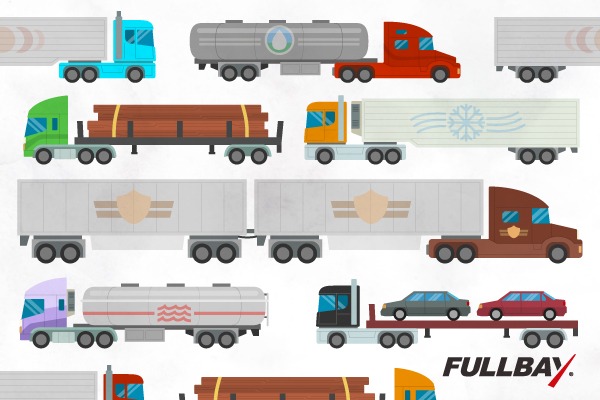Essential Introduction to Semi-Trucks and Trailers

Raise your hand if you can tell a sleeper from a day cab.
Okay, now put them down.
There’s probably no two ways about it: The majority of our readers are industry veterans who know a Peterbilt from a Freightliner. They definitely don’t need to learn about cabs and trailers.
If you’re among them, we love you! But friends, this post is not for you.
We do have a growing number of folks who are interested in the industry and want to learn more about it. We realized there wasn’t really an “industry primer” anywhere else on the web, so in true Fullbay fashion, we decided to create one!
We’ll get started discussing some of the biggest truck manufacturers and their most popular models, as well as some of the most popular trailers. By the time you’re done, you’ll be able to sort of have a conversation with your favorite tech or driver!
WHAT IS A SEMI-TRUCK?
Before anything else, let’s get one thing out of the way. Broadly speaking, a semi-truck is the truck itself – the forward part that contains the engine. It’s also called the cab.
Semi-truck is short for semi-trailer-truck. Everything the cab hauls behind it is the trailer.
When a semi-truck is hooked up to the trailer, you can call it a tractor-trailer. This setup is also referred to as an 18-wheeler, even though they might not all have 18 wheels.
Got it? OK, let’s move on. There are a couple types of cabs available:
Standard: Your regular trucks.
Sleeper: If you’re hauling goods across the country, you’re likely in a sleeper. These cabs vary from bare-bones setups (a bed and maybe a place to stash clothing) to luxurious offerings with chandeliers and wood floors (no, we’re not kidding). Generally, the bigger the cab, the more comfortably the driver can travel; some may have small kitchens, separate eating areas, and the like.
It breaks down even further from there. Generally, manufacturers produce two versions of each model: The one that fleets buy, and the one that owner-operators buy. One may come with slightly different bells and whistles than the other.
Now you know what a cab is and a bit about what you can expect to find in one. Let’s move on to the folks that build these beauties.
POPULAR MANUFACTURERS
There are plenty of truck manufacturers out there. For the purpose of this article, we’re not going to get too deep into the weeds. We’ve highlighted a few of the most popular manufacturers, along with some of their most famous models.

Peterbilt
Peterbilt’s first truck rolled onto highways in 1939. Headquartered in Denton, Texas, the company was founded by T.A. Peterman (get it? Peter “built”?) and is now owned by parent company PACCAR. It currently produces Class 6 through 8 vehicles.
Some of their most famous models are the Peterbilt 359 and Peterbilt 379. Currently, the Peterbilt 389 is a popular offering.

Kenworth
Kenworth burst onto the scene in 1923 under founder George T. Gerlinger. It’s headquartered in Seattle, Washington, and its parent company is also PACCAR. Coincidentally, that makes it both a rival and a sister brand to Peterbilt. The company currently produces Class 5 through 8 vehicles.
Its best-known model is probably the W900. The successor to that model is the W990.

International
International (or Navistar International) is one of the more modern companies on this list, arriving on American highways in 1986. Its truck manufacturing arm used to be International Harvesting, which goes all the way back to 1902. This holding company is headquartered in Lisle, Illinois, and it produces Class 4 through 8 vehicles.
You may have seen the International LoneStar, which is available as both a day cab and a sleeper. You’ve definitely seen the International 3300, aka a school bus!

Volvo
Volvo might be best known for its legendary station wagons, but it’s been churning out trucks of various types since 1928. Headquartered in Gothenburg, Sweden, and has manufacturing plants all over the world.
Its most popular heavy-duty model is probably the FH, but you’ve probably seen the FM model in that famous commercial with Jean-Claude Van Damme.

Freightliner
Freightliner Trucks has been around since 1929, and has been headquartered in Portland, Oregon, since then. It produces Class 5 through 8 trucks.
You’ve probably seen the Freightliner Cascadia on many a highway, and the Freightliner Inspiration is the first autonomous commercial vehicle to be licensed in the United States. It is not a driverless truck, but rather a sort of testing ground for what might become a driverless truck.
Feeling pretty good about the types of cabs out there? Okay, time to move on to bigger loads (pun intended). Let’s talk a bit about trailers!
TRAILERS
What is a trailer, anyway?
For our purposes, a trailer has no power source and must be towed by another vehicle (usually a semi cab).
There’s a trailer for just about every task you can imagine. We’re highlighting four of the most common trailers out there. Seriously, next time you get out on the road, starting counting. They’re all over!

Dry vans: You probably see at least a dozen of these every time you go on the freeway. They’re your standard big-rig, completely enclosed to protect whatever they’re carrying. They keep things dry, see?

Reefers: No, they aren’t carrying a certain kind of plant. Reefer is slang for refrigerator. These insulated trailers are climate-controlled to transport food, sometimes medicines, or other things that have to be kept cold or frozen.

Flatbeds: These don’t entirely look like trucks – they’re usually a long, flat platform with minimal sides (or no sides at all). You might see these guys filled with lumber, metal rails, or other heavy cargo.

Lowboys: These are the trailers that carry heavy equipment from one job site to another (think tractors, bulldozers, and the like). The “low” in its name comes from how close it sits to the ground (which is important; its lowness makes it easier for heavy equipment to board).
KEEP TRUCKING
Much like our glossary, we see this post as a sort of living document that we’ll update periodically. For now, enjoy the learnings. And if this was all old hat to you and you’re just here because you’re looking for some awesome repair shop software, well, we can help you there, too. Fullbay has made the lives of a lot of shop owners easier. Contact us for a free demo!

